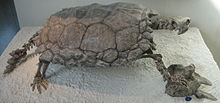Archelosauria
| Archelosaurs Temporal range: Possible Capitanian records. | |
|---|---|
 | |
| Proganochelys quenstedti | |
| Scientific classification | |
| Domain: | Eukaryota |
| Kingdom: | Animalia |
| Phylum: | Chordata |
| Class: | Reptilia |
| Clade: | Sauria |
| Clade: | Archelosauria Crawford et al., 2015[1] |
| Subgroups | |
| |
Archelosauria is a clade grouping turtles and archosaurs (birds and crocodilians) and their fossil relatives, to the exclusion of lepidosaurs (the clade containing lizards, snakes and the tuatara). The majority of phylogenetic analyses based on molecular data (e.g. DNA and proteins) have supported a sister-group relationship between turtles and archosaurs. On the other hand, Archelosauria had not been historically supported by most morphological analyses, which have instead found turtles to either be descendants of parareptiles, early-diverging diapsids outside of Sauria, or close relatives of lepidosaurs within the clade Ankylopoda. Some recent morphological analyses have also found support for Archelosauria.
Classification[edit]
Multiple sequence alignments of DNA and protein sequences and phylogenetic inferences have shown that turtles are the closest living relatives to birds and crocodilians.[2][3][4] There are about 1000 ultra-conserved elements in the genome that are unique to turtles and archosaurs, but which are not found in lepidosaurs.[5] Other genome-wide analyses also support this grouping.[6][7]
Archelosauria was named in a 2015 article by Crawford et al. The name is meant to evoke the archosaurs and chelonians (turtles), the two living subgroups of the clade. Crawford et al. defined Archelosauria as the clade formed by the descendants of the most recent common ancestor of Crocodylus niloticus (the Nile crocodile) and Testudo graeca (the Greek tortoise).[1] A 2021 article by Joyce et al. modified the definition to specifically exclude the lizard Lacerta agilis from the group.[8]
Below is the phylogeny from Crawford et al., showing interrelationships of Testudines at family level down to Durocryptodira. Archelosauria was grouped within Sauria (the clade formed by archosaurs and lepidosaurs), as the sister branch to Lepidosauria, the clade containing lizards, snakes and the tuatara.[1]
Analyses based on morphological data have generally recovered turtles either as non-diapsid reptiles nested within Parareptilia (a group of basal reptiles that lived from the Carboniferous to the Triassic), as early-diverging diapsids outside of Sauria, or as close relatives of Lepidosauria. The hypothetical clade formed by turtles and lepidosaurs to the exclusion of archosaurs is known as Ankylopoda.[8] A 2022 analysis by Simões et al. found a monophyletic Archelosauria using only morphological data for the first time, thus agreeing with most molecular analyses. Archelosauria was diagnosed by two unambiguous synapomorphies (shared derived traits): a sagittal crest on the supraoccipital bone, and the lack of an entepicondylar foramen on the humerus. A cladogram adapted from their analysis is shown below:[9]
Wolniewicz et al (2023) also found evidence for an expanded Archelosauria containing the three Mesozoic marine reptile clades of uncertain placement:[10]
References[edit]
- ^ a b c Crawford, N. G.; Parham, J. F.; Sellas, A. B.; Faircloth, B. C.; Glenn, T. C.; Papenfuss, T. J.; Henderson, J. B.; Hansen, M. H.; Simison, W. B. (2015-02-01). "A phylogenomic analysis of turtles". Molecular Phylogenetics and Evolution. 83: 250–257. doi:10.1016/j.ympev.2014.10.021. ISSN 1055-7903. PMID 25450099.
- ^ Shen, X.-X.; Liang, D.; Wen, J.-Z.; Zhang, P. (2011-12-01). "Multiple Genome Alignments Facilitate Development of NPCL Markers: A Case Study of Tetrapod Phylogeny Focusing on the Position of Turtles". Molecular Biology and Evolution. 28 (12): 3237–3252. doi:10.1093/molbev/msr148. ISSN 0737-4038. PMID 21680872.
- ^ Tzika, A. C.; Helaers, R.; Schramm, G.; Milinkovitch, M. C. (2011). "Reptilian-transcriptome v1.0, a glimpse in the brain transcriptome of five divergent Sauropsida lineages and the phylogenetic position of turtles". EvoDevo. 2 (1): 19. doi:10.1186/2041-9139-2-19. ISSN 2041-9139. PMC 3192992. PMID 21943375.
- ^ Chiari, Y.; Cahais, V.; Galtier, N.; Delsuc, F. (2012). "Phylogenomic analyses support the position of turtles as the sister group of birds and crocodiles (Archosauria)". BMC Biology. 10 (1): 65. doi:10.1186/1741-7007-10-65. ISSN 1741-7007. PMC 3473239. PMID 22839781.
- ^ Crawford, N. G.; Faircloth, B. C.; McCormack, J. E.; Brumfield, R. T.; Winker, K.; Glenn, T. C. (2012-10-23). "More than 1000 ultraconserved elements provide evidence that turtles are the sister group of archosaurs". Biology Letters. 8 (5): 783–786. doi:10.1098/rsbl.2012.0331. PMC 3440978. PMID 22593086.
- ^ Wang, Z. (27 March 2013). "The draft genomes of soft-shell turtle and green sea turtle yield insights into the development and evolution of the turtle-specific body plan". Nature Genetics. 45 (701–706): 701–6. doi:10.1038/ng.2615. PMC 4000948. PMID 23624526.
- ^ Field, D. J.; Gauthier, J. A.; King, B. L.; Pisani, D.; Lyson, T.; Peterson, K. J. (July–August 2014). "Toward consilience in reptile phylogeny: miRNAs support an archosaur, not lepidosaur, affinity for turtles". Evolution & Development. 16 (4): 189–196. doi:10.1111/ede.12081. PMC 4215941. PMID 24798503.
- ^ a b Joyce, W. G.; Anquetin, J.; Cadena, E.-A.; Claude, J.; Danilov, I. G.; Evers, S. W.; Ferreira, G. S.; Gentry, A. D.; Georgalis, G. L.; Lyson, T. R.; Pérez-García, A.; Rabi, M.; Sterli, J.; Vitek, N. S.; Parham, J. F. (2021). "A nomenclature for fossil and living turtles using phylogenetically defined clade names". Swiss Journal of Palaeontology. 140 (1): 5. Bibcode:2021SwJP..140....5J. doi:10.1186/s13358-020-00211-x. hdl:11336/155192. S2CID 229506832.
- ^ Simões, T. R.; Kammerer, C. F.; Caldwell, M. W.; Pierce, S. E. (2022). "Successive climate crises in the deep past drove the early evolution and radiation of reptiles". Science Advances. 8 (33): eabq1898. Bibcode:2022SciA....8.1898S. doi:10.1126/sciadv.abq1898. PMC 9390993. PMID 35984885.
- ^ Wolniewicz, Andrzej S; Shen, Yuefeng; Li, Qiang; Sun, Yuanyuan; Qiao, Yu; Chen, Yajie; Hu, Yi-Wei; Liu, Jun (2023-08-08). Ibrahim, Nizar (ed.). "An armoured marine reptile from the Early Triassic of South China and its phylogenetic and evolutionary implications". eLife. 12: e83163. doi:10.7554/eLife.83163. ISSN 2050-084X. PMC 10499374. PMID 37551884.


 French
French Deutsch
Deutsch





